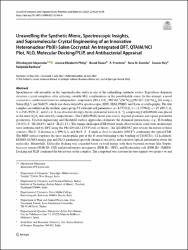| dc.contributor.author | Majumdar, Dhrubajyoti | |
| dc.contributor.author | Philip, Jessica Elizabeth | |
| dc.contributor.author | Tüzün,Burak | |
| dc.contributor.author | Frontera, A. | |
| dc.contributor.author | Gomila, Rosa M. | |
| dc.contributor.author | Roy, Sourav | |
| dc.contributor.author | Bankura, Kalipada | |
| dc.date.accessioned | 2023-04-12T05:28:24Z | |
| dc.date.available | 2023-04-12T05:28:24Z | |
| dc.date.issued | 26.07.2022 | tr |
| dc.identifier.citation | Dhrubajyoti Majumdar1,2 · Jessica Elizabeth Philip3
· Burak Tüzün4
· A. Frontera5
· Rosa M. Gomila5
· Sourav Roy6
Kalipada Bankura1
Received: 22 May 2022 / Accepted: 5 July 2022 / Published online: 26 July 2022
© The Author(s), under exclusive licence to Springer Science+Business Media, LLC, part of Springer Nature 2022 | tr |
| dc.identifier.uri | https://hdl.handle.net/20.500.12418/13571 | |
| dc.description.abstract | Spontaneous self-assembly in the supramolecular entity is one of the enthralling synthetic routes. It produces disparate structure crystal complexes after selecting suitable M-L combinations in the pseudohalide sense. In this attempt, a novel cocrystal is synthesized from two independent components (0D + 1D), [PbCd(L1)(SCN)2]·[PbCd(L1)(SCN)2]n (1) using a Salen (H2L1) and NaSCN, which was characterized by spectroscopic, EDX, SEM, PXRD, and X-ray crystallography. The title complex crystallizes in the triclinic space group P1 with unit cell parameters: a = 8.5733(2), b = 11.3798(2), c = 27.105(5) Å, V = 2583.95(9) Å3, and Z = 4. X-ray structure divulges the de-protonated form of [L−2], comprising Cd(II)/Pb(II) ions placed in the inner N2O2
and outer O4 compartments. The Cd(II)/Pb(II) metal ions satisfy trigonal-prismatic and square pyramidal geometries. Crystal engineering and Hirshfeld surface approaches delineate the dominant interactions, e.g., H-bonding (36.4%), C⋯H (20.8%), and S⋯H (21.1%). The unique chalcogen (ChB)/tetrel bonds observed in its solid-state architecture were authenticated by DFT using the PBo-D3/def2-TZVP level of theory. The QTAIM/NCI plot reveals the nature of these contacts. The S···S distance is 2.499(4) Å, and the C–S···S angle is close to linearity (168.8°), confirming the typical ChB. The MEP surface explores the most nucleophilic part at the N-atom belonging to the bonding of Cd-NCS (– 42 kcal/mol). HOMO–LUMO energy gap and NLO parameters provide chemical reactivity and sensitive optical information about the molecules. Meanwhile, Molecular docking was conceded based on total energy with three bacterial proteins like Staphylococcus aureus (PDB ID: 1JIJ) and pseudomonas aeruginosa (PDB ID: 3JPU), and Escherichia coli (PDB ID: 5MMN). Docking and PLIP confirmed the bioactivity of the complex. The compound was screened in vitro against two-gram + ve and two-gram -ve bacteria. The complex had lower MIC (μg/mL) values (10.1) compared to the parent ligand (32.7), implying
greater antimicrobial efficiencies. The time-kill kinetics led to the bactericidal activities of the complex. | tr |
| dc.language.iso | eng | tr |
| dc.publisher | springer | tr |
| dc.relation.isversionof | https://doi.org/10.1007/s10904-022-02448-0 | tr |
| dc.rights | info:eu-repo/semantics/openAccess | tr |
| dc.subject | Antimicrobial · Cocrystal · DFT · Molecular docking · PLIP · Salen ligand | tr |
| dc.title | Unravelling the Synthetic Mimic, Spectroscopic Insights, and Supramolecular Crystal Engineering of an Innovative Heteronuclear Pb(II)‑Salen Cocrystal: An Integrated DFT, QTAIM/NCI Plot, NLO, Molecular Docking/PLIP, and Antibacterial Appraisal | tr |
| dc.type | article | tr |
| dc.relation.journal | Journal of Inorganic and Organometallic Polymers and Materials | tr |
| dc.contributor.department | Sivas Meslek Yüksekokulu | tr |
| dc.contributor.authorID | https://orcid.org/0000-0002-0420-2043 | tr |
| dc.identifier.volume | 32 | tr |
| dc.identifier.endpage | 4339 | tr |
| dc.identifier.startpage | 4320 | tr |
| dc.relation.publicationcategory | Rapor | tr |















